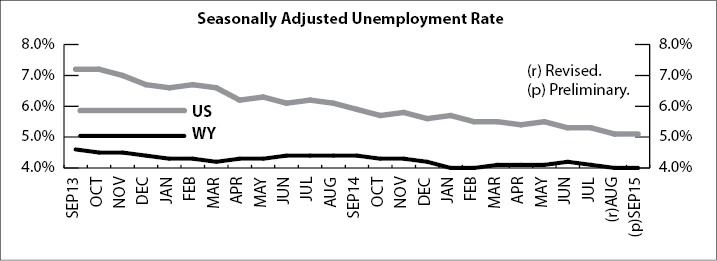
Wyo. Unemployment Rate Unchanged at 4.0% in September 2015
The Research & Planning section of the Wyoming Department of Workforce Services has reported that the state's seasonally adjusted1 unemployment rate was unchanged from August to September at 4.0%. Wyoming’s unemployment rate has remained within the narrow range of 4.0% to 4.2% in each of the past 10 months and is significantly lower than the current U.S. unemployment rate of 5.1%. Seasonally adjusted employment of Wyoming residents decreased slightly, falling by an estimated 478 individuals (-0.2%) from August to September.
From August to September, most county unemployment rates changed very little. Unemployment rates declined in Niobrara (down from 3.0% to 2.3%), Albany (down from 3.0% to 2.6%), Platte (down from 3.6% to 3.3%), and Fremont (down from 4.8% to 4.5%) counties. Slight increases were seen in Teton (up from 1.9% to 2.2%), Crook (up from 2.4% to 2.6%), Lincoln (up from 3.5% to 3.6%), Park (up from 3.1% to 3.2%), and Sublette (up from 4.0% to 4.1%) counties.
From September 2014 to September 2015, unemployment rates fell in 17 counties, rose in four counties, and were unchanged in Converse and Fremont counties. The largest decreases occurred in Niobrara (down from 3.4% to 2.3%), Carbon (down from 3.8% to 2.8%), Teton (down from 3.1% to 2.2%), and Sheridan (down from 4.1% to 3.2%) counties. Unemployment rates rose in Natrona (up from 3.8% to 4.4%), Sublette (up from 3.9% to 4.1%), Campbell (up from 3.2% to 3.3%), and Sweetwater (up from 3.9% to 4.0%) counties.
The highest unemployment rates were found in Fremont (4.5%), Natrona (4.4%), Sublette (4.1%), and Uinta (4.1%) counties. The lowest rates occurred in Teton (2.2%), Niobrara (2.3%), Crook (2.6%), and Albany (2.6%) counties.
Total nonfarm employment (measured by place of work) fell from 299,500 in September 2014 to 296,800 in September 2015, a decrease of 2,700 jobs (-0.9%; not a statistically significant change).
1Seasonal adjustment is a statistical procedure to remove the impact of normal regularly recurring events (such as weather, major holidays, and the opening and closing of schools) from economic time series to better understand changes in economic conditions from month to month.
